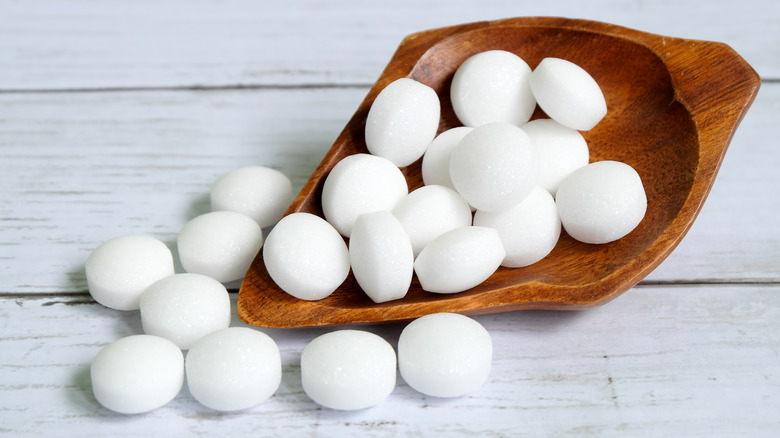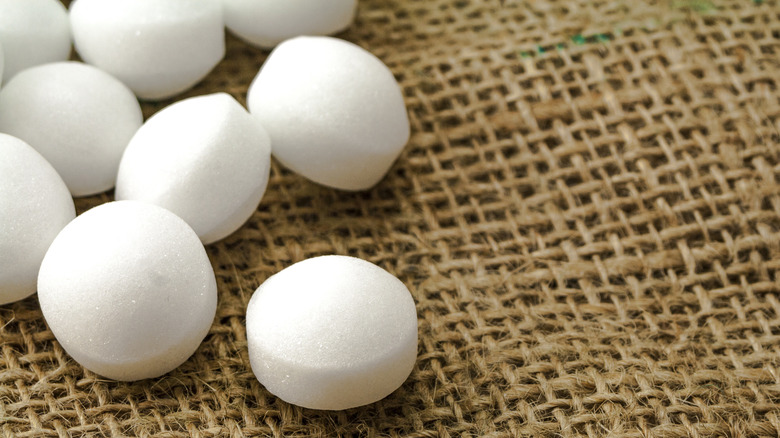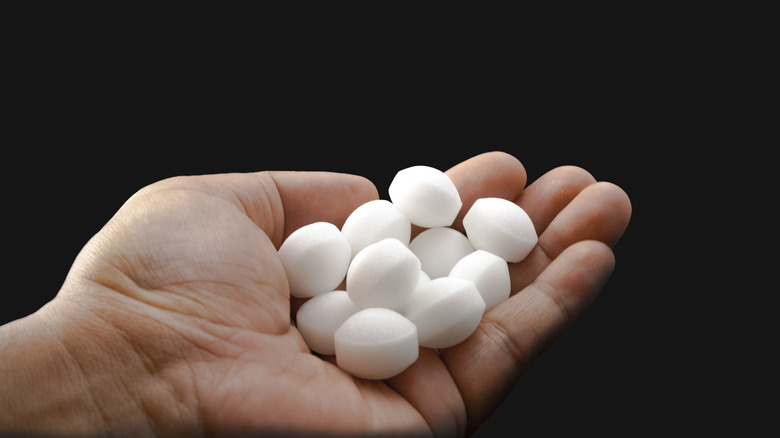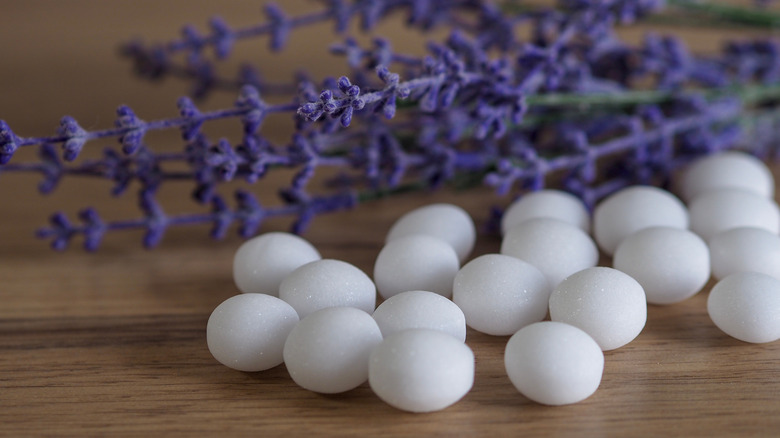The Right Way To Dispose Of Mothballs
You have seen these white, spherical balls used when storing clothes and other materials susceptible to moth, moth eggs, and moth larvae damage. While they may appear small and harmless, they are essentially pesticides that consist of either naphthalene or paradichlorobenzene as active ingredients, according to the National Pesticide Information Center. As such, mothballs are considered Household Hazardous Waste (HHW) and must be handled correctly and responsibly.
Although harmful to both humans and animals, mothballs come with advantages. They slowly emit toxic fumes that kill any moth and their eggs and larvae in your clothes. And thanks to their distinct, nostalgic smell, you can immediately tell if they have had contact with your belongings.
However, it is worth mentioning that using mothballs always comes with a risk. Prolonged exposure to its chemicals via inhalation can cause severe health problems. Children and pets could also mistake mothballs for food and ingest them, which can be deadly. And since WebMD notes that mothballs have been linked to the death of a baby in Australia, we thought it wise to look at the proper ways to handle and dispose of this household staple and provide safer alternatives.
Safe mothballs disposal tips
So what happens after you have bought mothballs, used up just a few, and don't know what to do with the rest of them? While the easiest solution is to throw them out, these insecticides are not your regular household waste, so you need to know how to dispose of them the right way. Let's look at the two primary ways to dispose of this household staple with which we have a complicated relationship.
As mentioned earlier, mothballs are HHWs and must only be disposed of at designated HHW disposal facilities. These facilities have the necessary equipment to destroy hazardous waste safely without contaminating the environment. To find the nearest HHW facility, use the search tool on the website of the United States Environmental Protection Agency. While these facilities do not charge money for drop-offs, you should know their working days, hours, and requirements.
The other viable option for disposing of mothballs that seems quite obvious is to simply use them up. Depending on how many of these balls you have in your possession, it may take some time to rid yourself of them all. Hence, it is best to gift them to avoid wastage.
Since mothballs are insecticides used to kill moths and their eggs and larvae from fabrics, some think throwing them in the yard to ward off pests and rodents is an excellent idea. While it might work in some instances, the risks outweigh the reward. According to the Yard Blogger, mothballs are toxic, and their chemicals can contaminate the soil and kill plants and beneficial organisms in your yard. It is also possible for their chemicals to find their way into a water source and lead to large-scale contamination altogether.
Though it is easy to execute, flushing mothballs down the drain is another horrible idea. These toxic substances can head straight to the community treatment plant and get back to our houses or be released into water bodies. How-To Dispose notes that mothballs evaporate faster when exposed to air; therefore, you can contaminate your indoor air while flushing them down the drain.
Handling mothballs safely
Now that you know how to dispose of mothballs, it is essential to learn how to handle them safely to avoid jeopardizing your health. Per How-To Dispose, here are a few things to consider.
First, always put on rubber gloves. While air contamination is common with mothballs, exposure to the skin is also very possible. Naphthalene and paradichlorobenzene can irritate if you fail to wash your hands right away, and they can also induce diarrhea and vomiting if you ingest food with contaminated hands. But rubber gloves can protect you from these chemicals, so we highly recommend them.
Second, store in air-tight containers. Since mothballs sublime to release fumes, the chemicals can pollute your indoor air and wreak havoc on your health. The Centers for Disease Control and Prevention report symptoms such as headache, nausea, vomiting, abdominal pain, and renal disease in households with prolonged mothball exposure. So, it is best to isolate your moth, moth egg, or larvae-infested clothes and put them in a sealable plastic bag, along with the mothballs. Ensure to wear a respirator if you are susceptible to allergies.
Third, remove the smell of mothballs from your clothes. After doing their job in the sealable plastic bag, it is imperative to wash the clothes before wearing them again or hanging them in your closet. However, if the clothes still reek of the chemical, hang them out to dry in the sun after a turn in the washing machine. Home Made Simple notes that white vinegar does a great job of removing mothball odor without staining the fabric. Once again, handle these clothing items with rubber gloves and a respirator if necessary.
And finally, keep away from children and pets. Children can mistake mothballs for candy and ingest them or play with them out of curiosity, leading to severe health issues. Regarding your furry friends, PetMD states that possible reactions include a dysfunctional nervous system, kidney failure, and cataracts, depending on the chemical composition in the mothball. It is also worth mentioning that cats are more susceptible to the toxic chemicals in mothballs than dogs.
Mothballs alternatives
While mothballs are quite effective in getting rid of moths, there are other natural ways of producing similar results. It is worth mentioning that many of these natural remedies will not expose you and your family to chemicals. The Storage Space details the following alternatives:
Cedar chips are a popular option that helps to keep away pesky bugs without leaving your home and belongings reeking of mothballs. They have a refreshing smell and a longer shelf life, remaining effective for more extended periods. If you tuck several cedar chips inside your closet, your clothes will stay fresh, uncontaminated, and moth free.
The lovely scent of lavender acts as a natural repellant for moths and other insects. Using lavender as an alternative will leave your clothes smelling fresh even after months of usage. There are plenty of ways you can use lavender in your closet. First, place lavender sachets in your closet and let the lovely scent infuse into your clothing items. The other way is to put a few drops of lavender oil extract on a piece of cotton and place it in the problematic areas. Be sure to suspend the cotton as lavender often stains.
The final way of making sure your stored winter clothes are moth free is to clean them beforehand. While it is essential to launder them first, it is equally necessary to ensure that the clothes are free of moisture. Washing your clothes rids them of the moth attracting scents and kills pre-existing moths and their eggs and larvae.



